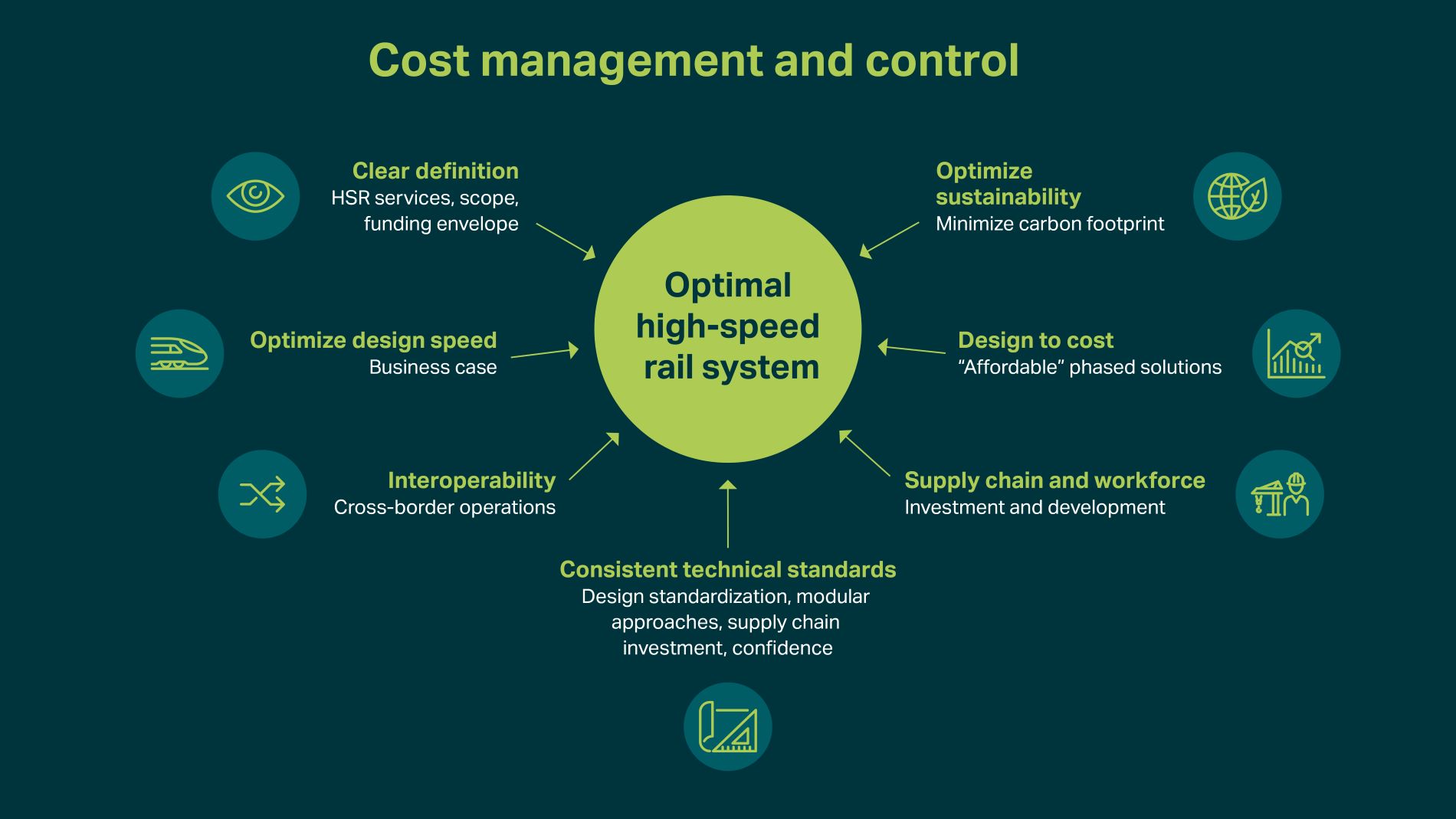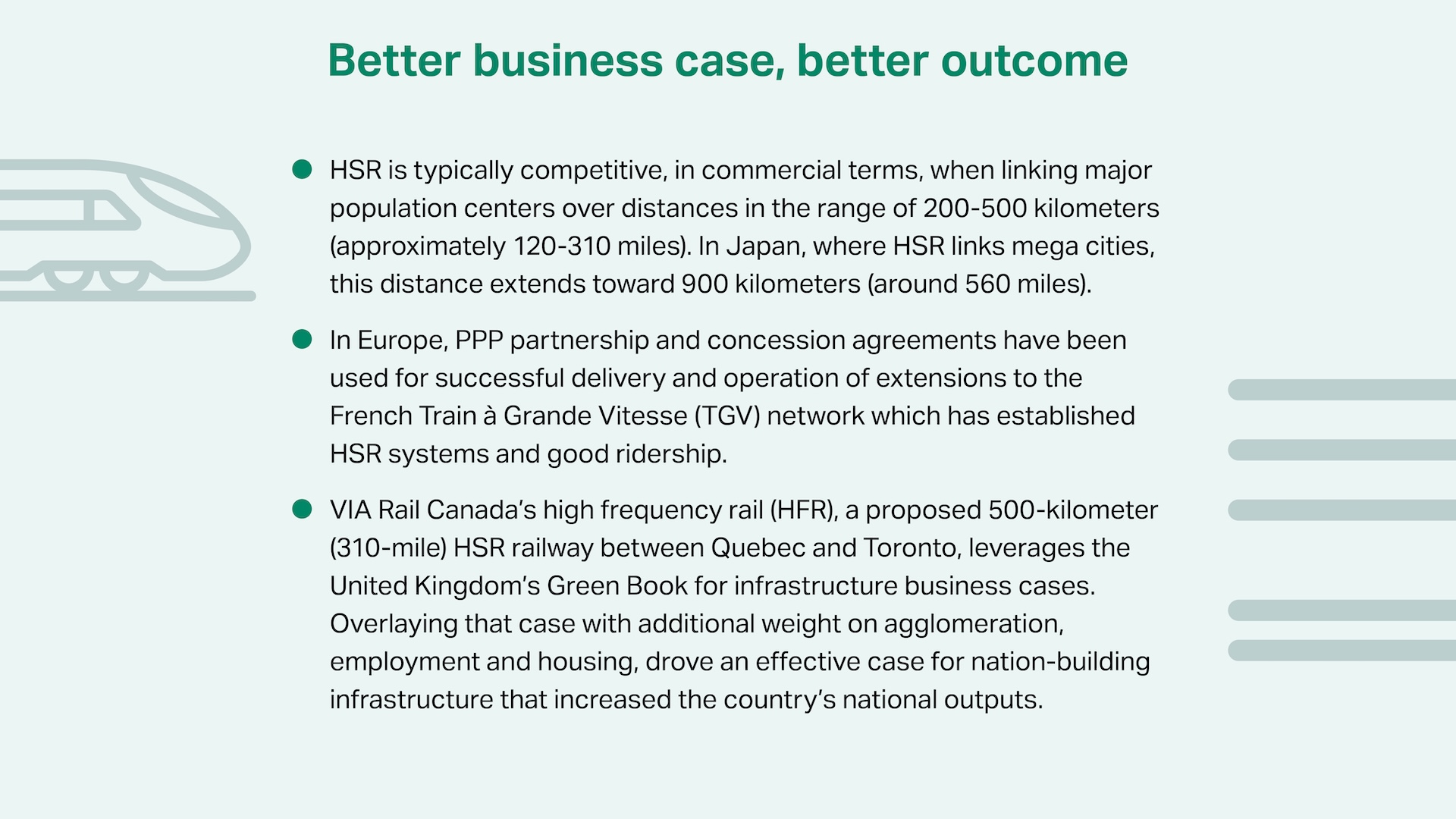Understanding challenges for high-speed rail in the Middle East
More than three billion passengers around the world travel by HSR each year. Mainland China hosts more than two-thirds of the world’s total network, with Japan and Spain seeing strong benefits and returns from their established systems. Elsewhere, Canada, the United States (U.S.), Australia, Morocco and the United Kingdom (U.K.) all have ambitious plans to capitalize on its potential.
The Middle East is now well-positioned to benefit from HSR’s opportunities. Our rail and transit lead for the Middle East and Africa, Gordon Lindsay, global transit director, Russell Jackson, and our global transit director for major projects, John Barker, explain what it takes to get a successful HSR project off the ground.
A strong start for HSR in the Middle East
HSR has begun to show potential in the Middle East through several recent developments. In Saudi Arabia, the North Railway provides 1,550 kilometers (more than 950 miles) of freight and 1,250 kilometers (approximately 775 miles) of passenger lines, linking the capital city of Riyadh with Al-Haditha, which sits across the border from neighboring Jordan. Elsewhere, the Haramain High-Speed Railway connects the holy cities of Mecca and Medina, reducing travel time for pilgrims to under 2.5 hours.
Further planned developments include the Saudi Landbridge, linking the coastal city of Jeddah to Riyadh, and the Gulf Cooperation Council (GCC) Railway, which is proposed to connect all six GCC member states in Eastern Arabia, stretching 2,177 kilometers (1,353 miles). With these current and future projects, the Middle East is on its way to establishing a mature HSR network.
HSR benefits
New HSR projects can bring cities and communities together, boost economies and promote sustainability while enriching regions socially and financially. The benefits include:
Unlocking growth. By increasing the movement of people and goods across regions, HSR drives progress. In a survey published in our 2024 research report, From vision to reality: A new high-speed rail playbook, 89 percent of professional industry respondents identified HSR projects as catalysts for economic stimulation and 77 percent say HSR can drive major positive societal impacts.
Reducing carbon emissions. HSR has a lower lifetime carbon impact when compared with alternative modes of transportation such as air, road transport and diesel-powered trains. Recent construction methods, for instance, those employed by High Speed Two (HS2) in the U.K., have contributed to this. The project employed new low-carbon materials, such as concrete, that provide a 42 percent reduction in carbon emissions. Further, HSR electric trains lose only 5 percent of energy during combustion, versus 65–70 percent for diesel-powered trains.
Enhancing integration. Through careful planning and design, HSR can provide interoperability with existing regional networks, offering a point-to-point solution for passengers and freight. In Europe the Lyon-Turin line, which is expected to be operational in 2033, connects with the existing Trans-European Transport Network (TEN-T) Mediterranean Corridor, and will bring a new HSR link for freight and passengers traveling between Italy and France.
Middle East HSR challenges
HSR projects in the Middle East face several region-specific challenges that operators must address early to ensure successful delivery. Below are four key considerations:
1. Prove a strong business case. Establishing a demonstrable business case is essential to secure investment. HSR project leaders must manage capital costs and illustrate how the plans support economic growth and improve connectivity — both within regional networks and across modes of public transportation. This calls for efficient, robust delivery models that help identify the best funding opportunities on a case-by-case basis.
2. Effective planning and phasing. Early planning and phasing — including demand modeling and understanding population distributions — helps manage costs and unlock benefits as a project is underway. In Spain the world’s second largest HSR network, Alta Velocidad Española (AVE), used a phased approach that included constructing a temporary station, Valencia Joaquin Sorolla. Designed for later dismantling and therefore built from recyclable materials, the station helped deliver early and ongoing project benefits.
3. Implementing engineering expertise. Addressing unique engineering challenges, such as terrain and environmental conditions, requires expert insights to meet HSR’s high safety and efficiency standards. Windblown sand, wide temperature ranges and remote locations are key regional factors that need consideration. Interoperability for future connections is also something to consider. While current demand in the region may focus on freight, experience shows that passenger demand often follows. Planning for this from the outset can prove cost-effective long term.
4. Efficient delivery and standards. Standardization and modularization enable repeatability, drive measurable efficiencies and reduce costs. Standardization also gives more certainty around cost estimations. Taiwan’s approximately 350-kilometer (around 217-mile) HSR made extensive use of standardized designs and modular construction. Clear standards build supply chain confidence, encouraging investment in the necessary capabilities, expertise and equipment required for efficient delivery.

Exceptional opportunities
The true value of an HSR line becomes apparent once it’s operational. Feedback from past projects highlights a consistent set of priorities for evaluating project success within the first year of operation. Of the various factors identified, respondents believe success is measured primarily on an HSR line’s ability to drive economic growth, employ innovative technology, adapt to future change and result in on-time delivery.
By preparing to meet the diverse challenges, countries across the Middle East can share in the many economic and societal benefits that HSR offers.
To learn more, please contact our Middle East high-speed rail team.







